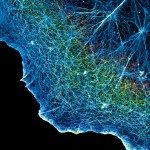Link to Pubmed [PMID] – 32783880
Link to DOI – S1534-5807(20)30584-010.1016/j.devcel.2020.07.010
Dev Cell 2020 Sep; 54(6): 773-791.e5
Local translation allows spatial control of gene expression. Here, we performed a dual protein-mRNA localization screen, using smFISH on 523 human cell lines expressing GFP-tagged genes. 32 mRNAs displayed specific cytoplasmic localizations with local translation at unexpected locations, including cytoplasmic protrusions, cell edges, endosomes, Golgi, the nuclear envelope, and centrosomes, the latter being cell-cycle-dependent. Automated classification of mRNA localization patterns revealed a high degree of intercellular heterogeneity. Surprisingly, mRNA localization frequently required ongoing translation, indicating widespread co-translational RNA targeting. Interestingly, while P-body accumulation was frequent (15 mRNAs), four mRNAs accumulated in foci that were distinct structures. These foci lacked the mature protein, but nascent polypeptide imaging showed that they were specialized translation factories. For β-catenin, foci formation was regulated by Wnt, relied on APC-dependent polysome aggregation, and led to nascent protein degradation. Thus, translation factories uniquely regulate nascent protein metabolism and create a fine granular compartmentalization of translation.



